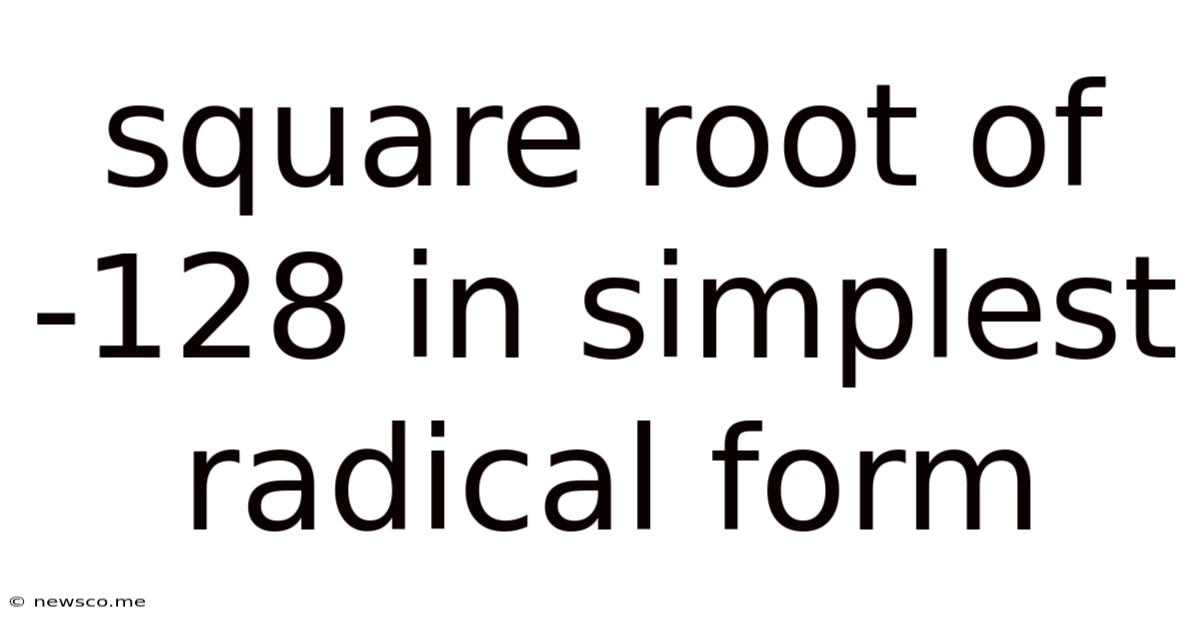Square Root Of -128 In Simplest Radical Form
News Co
Apr 18, 2025 · 5 min read

Table of Contents
Simplifying the Square Root of -128: A Deep Dive into Imaginary Numbers
The square root of -128, denoted as √-128, presents a fascinating challenge in mathematics. Unlike the square root of a positive number, which yields a real number, the square root of a negative number introduces us to the realm of imaginary numbers. This article will guide you through a step-by-step simplification of √-128, explaining the underlying concepts and providing a solid foundation in working with imaginary and complex numbers.
Understanding Imaginary Numbers
Before diving into the simplification, let's establish a crucial understanding of imaginary numbers. The fundamental building block is the imaginary unit, represented by the letter i. i is defined as the square root of -1:
i = √-1
This seemingly simple definition opens up a whole new branch of mathematics. Any number that can be expressed as a real number multiplied by i is considered an imaginary number. Examples include 2i, -5i, and πi.
Simplifying √-128: A Step-by-Step Approach
To simplify √-128, we leverage the properties of square roots and the definition of i. Here's the breakdown:
-
Factor out -1: The first step involves separating the negative sign from the radicand (the number inside the square root). This allows us to introduce the imaginary unit i.
√-128 = √(-1 * 128)
-
Separate the square root: Using the property √(a * b) = √a * √b, we can separate the square root into two parts:
√(-1 * 128) = √-1 * √128
-
Introduce the imaginary unit: Substitute i for √-1:
√-1 * √128 = i√128
-
Simplify the square root of 128: Now we focus on simplifying √128. We look for perfect square factors of 128. The prime factorization of 128 is 2<sup>7</sup>. We can rewrite this as 2<sup>6</sup> * 2. Since 2<sup>6</sup> is a perfect square (64), we can simplify further:
√128 = √(2<sup>6</sup> * 2) = √(2<sup>6</sup>) * √2 = 2<sup>3</sup>√2 = 8√2
-
Combine the results: Finally, combine the imaginary unit and the simplified square root:
i√128 = 8i√2
Therefore, the simplest radical form of √-128 is 8i√2.
Complex Numbers: A Broader Perspective
While we've successfully simplified √-128 into its simplest radical form, it's important to understand that this result is a complex number. Complex numbers are numbers that have both a real and an imaginary part. They are typically expressed in the form a + bi, where 'a' is the real part and 'b' is the imaginary part.
In our case, the simplified form 8i√2 is a purely imaginary number because the real part (a) is 0. However, other square roots of negative numbers can result in complex numbers with both real and imaginary components.
Practical Applications of Imaginary and Complex Numbers
While the concept of imaginary numbers might seem abstract, they have significant practical applications in various fields:
-
Electrical Engineering: Imaginary numbers are crucial in analyzing alternating current (AC) circuits. They are used to represent impedance, a measure of opposition to the flow of current in AC circuits. The use of complex numbers simplifies the calculations considerably.
-
Quantum Mechanics: Complex numbers are fundamental to the mathematical framework of quantum mechanics. Wave functions, which describe the state of a quantum system, are often represented using complex numbers.
-
Signal Processing: In signal processing, complex numbers are essential for representing and manipulating signals in the frequency domain. This allows for efficient filtering, compression, and other signal processing tasks.
-
Fluid Dynamics: Complex numbers are used in analyzing fluid flow problems, particularly those involving potential flow and conformal mapping.
-
Fractals: The generation of beautiful and complex fractals, such as the Mandelbrot set, heavily relies on iterative calculations using complex numbers.
Further Exploration: Higher Order Roots of Negative Numbers
The techniques used to simplify √-128 can be extended to higher-order roots of negative numbers. For example, to simplify the cube root of -8, we can follow a similar process:
∛-8 = ∛(-1 * 8) = ∛-1 * ∛8 = -2
Notice that unlike the square root, the cube root of a negative number is a real number. The behavior of roots of negative numbers depends on whether the root is even or odd.
Troubleshooting Common Mistakes
When simplifying square roots of negative numbers, some common mistakes to avoid include:
-
Forgetting the imaginary unit: The most frequent error is neglecting to include the imaginary unit (i) when dealing with the square root of a negative number. Always remember that √-1 = i.
-
Incorrect simplification of the radical: Ensure you correctly simplify the square root of the positive part of the number. Remember to look for perfect square factors to simplify the expression effectively.
-
Mixing real and imaginary parts improperly: When dealing with complex numbers, be careful to keep the real and imaginary parts separate. Don't try to combine them directly.
Conclusion: Mastering the Fundamentals
Understanding the simplification of expressions like √-128 is essential for building a solid foundation in mathematics and its numerous applications. By mastering the concept of imaginary numbers and complex numbers, you unlock a door to a fascinating world of mathematical possibilities, enabling you to tackle more complex problems and appreciate the elegance and power of these seemingly abstract concepts. The systematic approach outlined in this article, combining the principles of square root simplification with the properties of imaginary numbers, will equip you to confidently handle similar expressions and further delve into the rich field of complex numbers. Remember to practice regularly to solidify your understanding and build your problem-solving skills.
Latest Posts
Related Post
Thank you for visiting our website which covers about Square Root Of -128 In Simplest Radical Form . We hope the information provided has been useful to you. Feel free to contact us if you have any questions or need further assistance. See you next time and don't miss to bookmark.